Remembering Philip C. Lowe
The woodworking community pays tribute to one of its giants.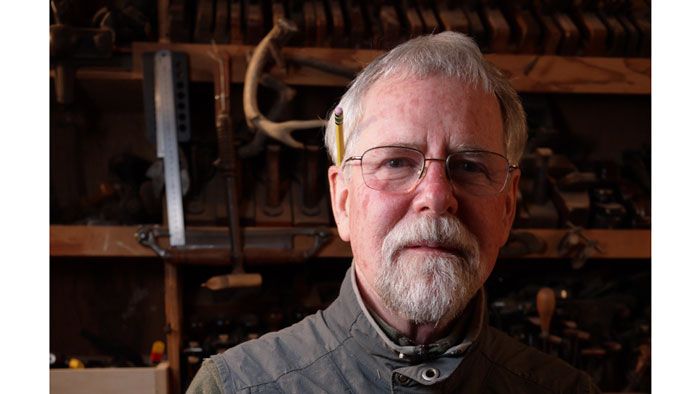
The woodworking community has lost one of its giants with the passing of Philip C. Lowe. He was a consummate craftsman and former instructor and head of the furniture making program at North Bennet Street School in Boston, and later at his own school, The Furniture Institute of Massachusetts. But if you were to ask any of the number of people who have known and worked with Phil, the first thing you’d hear about is what a tremendously kind and generous individual he was.
In the handful of times I’ve had the pleasure to work with Phil, I was always greeted by his smile, quick wit, and great sense of humor. Of course, when he’d get to work, all my attention turned to his tremendous skill and the seeming ease with which approached his work. For those of us not fortunate enough to have studied under Phil, the good news is that he has been a consistent contributor to the magazine for more than 30 years. The articles that he has written over the years stand as a testament to his skill and the generosity with which he shared his insights, though sadly they only skim the surface of his knowledge and experience.
—Michael Pekovich, FWW editor and creative director
As a woodworker, Phil Lowe was second to none. He was a master of his craft, having built a lifetime of furniture worthy of inclusion in any museum. He was a man of character and a passionate teacher who inspired countless woodworking students.
I first met Phil in 2004 when I took a weeklong hand-tool class with him at the Center for Furniture Craftsmanship in Maine. I was a bit nervous. After all, I was about to take a class with a legend. Turns out this masterful woodworker was simply Phil—no pretenses, no airs, just an approachable, knowledgeable, and engaging instructor. He was a tough teacher, though. I recall the sharpening section of the class, when we were flattening the back of a plane blade. Phil would not let a student move on to the next sharpening grit until he was satisfied that all the scratches from the previous grit were gone. That was a sweaty workday for us students, but by sunset we all realized the satisfaction of a job well done.
Since then, I have worked with Phil on many Fine Woodworking articles and projects, including Fine Woodworking Live. Every room in his shop in Beverly, Mass., was filled with history. There were table legs strung up all around, hundreds of hand tools arranged on shelves all sharp and ready to work, chair and carving patterns galore, and projects finished and underway. Phil’s head was full of woodworking tips and techniques, and every photo shoot with him also served as a woodworking class.

More than the woodworking lessons, however, I will remember the conversations I used to have with Phil. His life was full of stories, and he could always pull a tale from his days in the Navy. He was passionate about furniture making, but he also had a love of sailing, of being on the water at sunset and experiencing the fullness of East Coast shoreline living. Phil was a dedicated family man, who spoke lovingly and proudly of his wife Sandra and their family. Conversations never completely revolved around him, however. Phil was interested in people. He wanted to hear about you, wanted to know your inspirations and aspirations, your successes and your failures.
I reached out to Phil in the spring when I learned of his illness. He was upbeat, telling me, “We’ll fight this thing like we build furniture: One board at a time.” Simple, direct, determined. Just like Phil.
The world has lost a master woodworker, but woodworkers have lost a friend.
—Tom McKenna, Group Editorial Director
Phil’s knowledge of American period furniture was encyclopedic. His eye for detail and carving ability was amazing. I stood in awe of his creations, each and every one. He was such a fine teacher, willing to share and guide. And a wonderful human being.
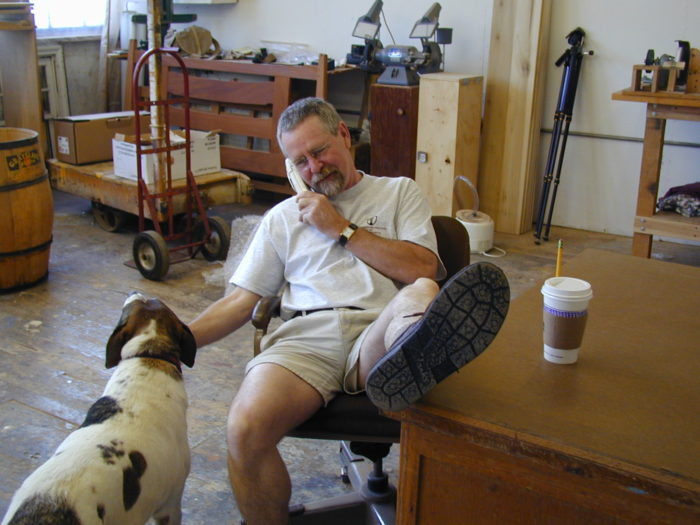
Phil Lowe lived in a world I never inhabited. He lived in the 18th century with the furniture makers John and Thomas Seymour. Phil’s skills were so divergent from our last century and its search for the quick and ephemeral that it’s hard to imagine him comfortable living with us at all. He told me once that he signed all his construction drawings for the sake of “provenance.” He understood his place in the world of antique restoration and furniture making. He told me that he had once put his name on a clock alongside other makers and the silversmith’s, Paul Revere. His technical skills at woodworking were stunning, vast. He was a woodworking savant from his high school and Navy days and forward. If there was an 18th-century technique, he had mastered it. He was simply the finest and most skilled furniture maker I have ever known.
After one evening at a presentation he and I gave, I told my host afterward, “Never do a slide show with Phil Lowe.” His work was not original in the ordinary sense. It was stunning, though, in its grasp of technique and skills long thought past but reborn in his hands. What Phil could do with a chisel or lathe or veneer hammer he did with such ease, such skill, such speed, all I could do was sit back and wonder at it.
Phil once took me to see the Seymour & Sons exhibit at the Peabody Essex Museum when I visited him. The museum guard followed us around so he could hear what Phil was saying about the work. I don’t know how many times we set off the alarms on our hands and knees while Phil pointed out some unique feature or curious bit of veneer work. With his impish charm and disarming wit, I could only marvel at his skills. There are few folks born with a chisel in their hands. Phil was one of those. A marvel, my friend.
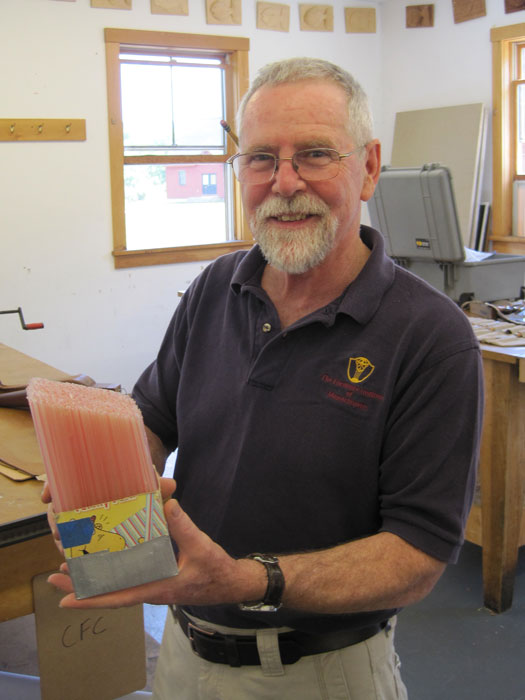
Phil Lowe’s passing leaves an irreparable hole in our community. He was a peerless craftsman, superb instructor, and as fine a person as you could hope to meet. Over the past 20 years, Phil kindly took time away from his own superb school to teach at ours on several occasions. At Monday night slide shows, we were humbled and uplifted by the breadth and depth of his work. The last time I saw Phil, he was beaming, in his own generous and understated way, to see one of his students take Best of Show at the 2019 Fresh Wood competition at the AWFS Fair in Las Vegas. Walking his own path through life, Phil left a remarkable legacy in the hearts of those of us whom he touched as a teacher, mentor, and friend.
—Peter Korn, Executive Director, Center for Furniture Craftsmanship
Knowing and working with Phil Lowe through the years has been a special honor. When I spoke to him at various woodworking shows or dropped by his school for a visit, he had a way of making me feel genuinely valued. I never had the slightest sense that my many questions were a nuisance or that he didn’t have the time for me. In 2019 I had the privilege of teaching a weeklong carving class at his school. Just spending time at his school, getting to know Phil more, and seeing him freely and naturally share golden nuggets of knowledge with the students was very special. His vast knowledge will live on through the many students he has touched and the generosity he has shown to both friends and strangers.
Like many young FWW editors, I came to the magazine to expand my knowledge of the craft, intimidated but excited to meet the luminaries who were featured regularly. I can safely say I learned more from Phil Lowe than any other craftsman I worked with, and I worked with all the greats.
I learned that when you know something deeply, you don’t have to bang the drum loudly. Phil would never say a bad word about other woodworkers or their work, no matter how dubious their methods. He would just say, in effect, “I do it this way, and it seems to work well.”
Phil had been a woodworking genius since he left the military as a young man and entered North Bennet Street School, where he completed more reproductions than anyone else in the history of the program. He was a legend in the world of period furniture making, and he didn’t have any points to prove.
I also learned that when you understand something deeply, you can clarify it simply. Like all of the best technicians, Phil didn’t see wood as mysterious or magical, but beautiful and predictable. If you understand wood and tools the way Phil did, world-class work becomes a matter-of-fact, learnable skill.
I learned from Phil that it’s the work that matters, not the tools or the talk. The way Phil made his tools work was what made them beautiful, not their pedigree or price tag. And his shop was just one more tool, no fancier than it needed to be. The work that went out the door, however, was jaw-dropping.
What I’m missing most about Phil on this very sad day are his humility, generosity, and kindness. He never looked down his nose at my dumb questions, and always embraced my role as a photographer and collaborator, working to transfer his genius onto the printed page. (My favorite that I shot and edited is “Surface Prep: Why Sanding Isn’t Enough,” in FWW #152, because it epitomizes Phil’s practical genius.)
After every shoot, we always had a steak and a beer near his shop in Beverly, Mass., and just talked about life. It has been a profound honor to know and work with Phil Lowe, and his legacy will live on in my heart and hands.
—Asa Christiana, former editor of FWW
Like many folks, my earliest acquaintance with Phil was through is articles. I was building my first Queen Anne piece and turned to his article from issue #42, “Cabriole Legs: Hand-shaped, without a lathe,” an article I have given my students many times since. I was a novice to the trade and he was already sharing his knowledge. Bottom line, in my early twenties, he was the craftsman that I wanted to be when I grew up!

Because we taught workshops at many of the same schools, our paths crossed on several occasions. As a former conference planner for The Society of American Period Furniture Makers, I turned to Phil more than a few times to demonstrate and speak at our summer events. He was one of our most popular presenters and it was not uncommon for attendees to skip other demonstrations just to watch Phil twice. He knew his stuff, was a master of it, and knew how to share it.
Over many meals and more than a few beers, I came to know Phil as generous man who liked to laugh and engage in lively conversations. He was utterly dedicated to his family and passionate about his craft. He invested his heart into his school and we are blessed for the number of artisans who studied under his gifted hands at The Furniture Institute of Massachusetts, The North Bennet Street School, and the many guilds and private schools across the country.
One day, I had the privilege of seeing Phil totally out of context, not in the shop or near the wood. I was visiting him in Beverly and he took me out sailing for the day. I have a vague memory of the boat or where we specifically sailed but I have a vivid recollection of the pilot. He beamed a deep satisfaction from just sailing along. He was in a sanctuary that gave him great peace. I’ll never forget the smile on his face. I feel blessed to have known him and 35-plus years later, I still want to grow up and be like Phil.
Philip C. Lowe had a knack. He knew how to make people comfortable around him, how to inspire great work, how to convey difficult concepts. He knew how to lead a student to the brink of discovery, then step back and see the light go on. He knew that teaching in this field has to include doing; and enough of that doing leads to the deep understanding that comes wrapped in the satisfaction of making great furniture.

Phil made beautiful objects and drew wonderful, clear plans of furniture, period and beyond. He ran programs, wrote constantly, consulted for museums, traveled nationwide teaching and lecturing, raised a wonderful family, and founded a nationally acclaimed school that he nurtured to the end.
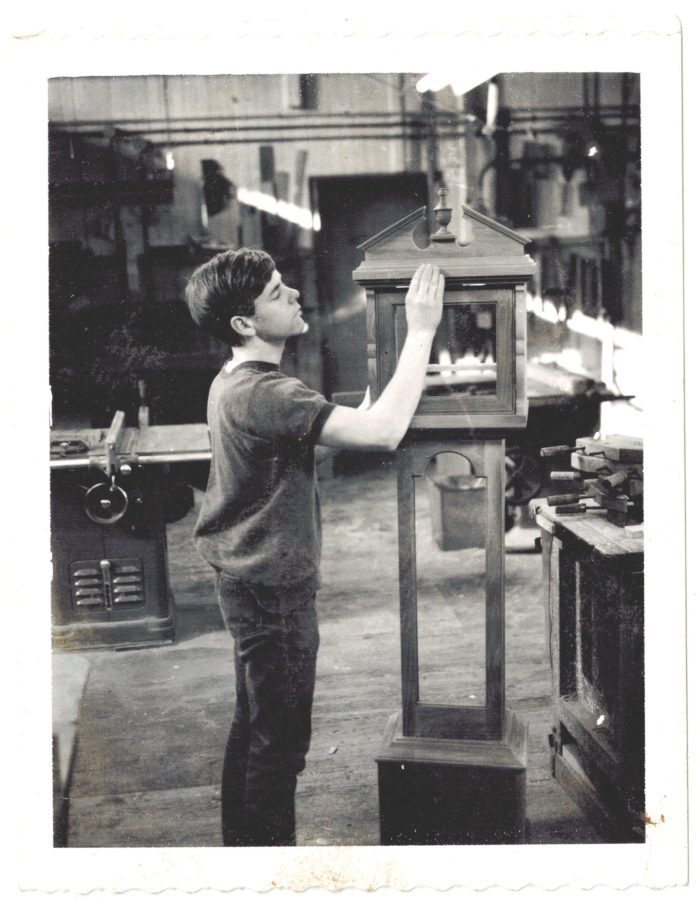
I taught at The Furniture Institute of Massachusetts for almost 10 years, mostly night and weekend courses. Phil was always there to greet my students, check on their work, show us something a full-time student (or he himself) was working on, and just generally share his overall enthusiasm for the craft and work done well. Often, he’d stay for most of a three-hour night class after teaching and working all day—just because he loved what he did.
Phil had a dry, Yankee sense of humor and the inherent frugality that went with it, imploring students to return all hide glue drippings to the hot bucket. He also had an open mind—I come from a different woodworking background (not period furniture at all) yet he hired me to teach, introducing me as someone who had “drunk the Kool-Aid” out on the West Coast (one of his last projects was a cabinet on a stand…hmmm….).
Most of all, Phil had a knack for making community—for bringing people together, making them feel welcome and a part of the special place(s) he created. What a gift! I am grateful to have played a part and have difficulty expressing the depths of my sorrow at his passing and the loss of the school.
Thank you, Phil.,
—John Cameron
Phil Lowe has been an icon to me from the start of my woodworking career. I knew of him before I went to the North Bennet Street School Cabinet and Furniture Making program. I remember making my family watch the VHS tape of him “Carving the Ball and Claw Foot.” I started teaching workshops after graduating from NBSS and soon after, Phil Lowe asked if I would be willing to come and teach at his Furniture Institute in Beverly, Mass. I was quite honored to be able to work with him and teach at his school. He was a kind and patient teacher able to reach out to all who had an interest in learning what he knew. This made him an excellent teacher not only to his students but for me as well. Working with Phil made me a better teacher and I am eternally grateful for the time I was able to spend with him.
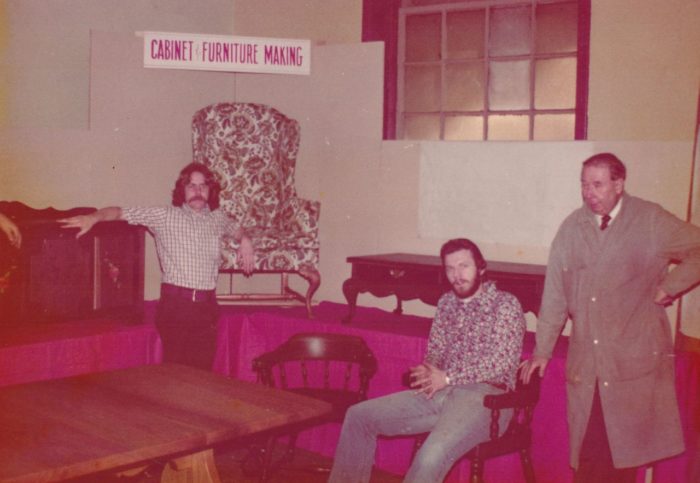
Phil Lowe and George Fullerton were the instructors for the Cabinet and Furniture Making course at the North Bennet Street School in 1977 when I started as a student. It wasn’t very far into the course when Phil gathered me and two other students for machine maintenance for the jointer.
I was a bit shocked when Phil directed us to completely disassemble the jointer (less the electric motor), clean all the parts, and re-assemble it with proper lubrication and alignment. This was Phil’s regular machine maintenance for most of the machines, tablesaws, planer, shaper, hollow-chisel mortiser, drill press, lathes, scrollsaw, and compressor (we did not disassemble the large Fay& Egan Bandsaw completely). We attributed this degree of maintenance to Phil’s time in the Navy. Phil was on a service ship that provided maintenance for other deployed ships. It had woodworking and metalworking machinery on board that were surely maintained. With this task Phil showed us that “doing it” is a major tenet in understanding and that it improves our skills and gives us confidence in our own abilities.
Shortly after I graduated from the CFM course in 1979, Phil asked me to become a part-time instructor. My duties were to keep the shop and machine room open for extra hours for students, and to teach Machine Maintenance. It was an opportunity for me to continue learning from Phil.
He is a great teacher! He lived his life doing it. He enriched the lives of so many.
—Lance Patterson, Instructor of Cabinet & Furniture Making, North Bennet Street School
Phil was a furniture maker’s furniture maker. He knew the classic styles of the 18th century and accumulated a vast kit of the tricks and techniques and the hows and whys of traditional design. Need to reproduce a unique Seymour banding or Goddard carved shell? Ever humble, Phil would show you how.
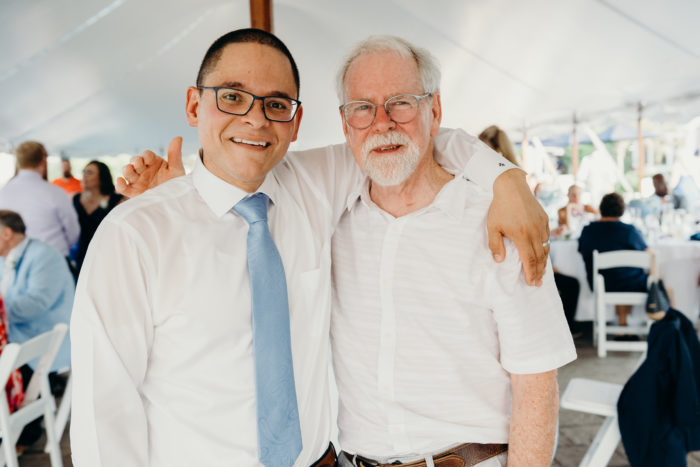
As you can imagine, choosing just one memory to mark my time with Phil is extremely difficult. One memory, an example of his incredible generosity, stands out:
 My last semester at the Furniture Institute of Massachusetts (FIM) was in 2006. Unfortunately, I reached a place where I realized I was not able to pay for my last semester of school, despite working full time while also going to school. I was faced with making what felt like an impossible decision: pack up and return home, meaning I would not graduate; or, become homeless, so I could use my rent money towards FIM. I approached Phil, hoping we could come up with a payment plan so I could remain his student. I believe that Phil saw the stress in my eyes and my passion for remaining at FIM. Shortly thereafter, he called me into his office and he told me that he wanted me to finish. He made me an offer I could never refuse, and for which I will always be grateful. Phil asked me to work for him, generously putting 50% of every job on which I worked toward my balance for the semester. Phil made a personal sacrifice in not having my tuition up front, in order to continue fostering my love for woodworking. Phil Lowe was a master of his craft, an outstanding teacher, and above all, a truly generous man.
My last semester at the Furniture Institute of Massachusetts (FIM) was in 2006. Unfortunately, I reached a place where I realized I was not able to pay for my last semester of school, despite working full time while also going to school. I was faced with making what felt like an impossible decision: pack up and return home, meaning I would not graduate; or, become homeless, so I could use my rent money towards FIM. I approached Phil, hoping we could come up with a payment plan so I could remain his student. I believe that Phil saw the stress in my eyes and my passion for remaining at FIM. Shortly thereafter, he called me into his office and he told me that he wanted me to finish. He made me an offer I could never refuse, and for which I will always be grateful. Phil asked me to work for him, generously putting 50% of every job on which I worked toward my balance for the semester. Phil made a personal sacrifice in not having my tuition up front, in order to continue fostering my love for woodworking. Phil Lowe was a master of his craft, an outstanding teacher, and above all, a truly generous man.
I met Phil about 20 years ago at the Providence Fine Furnishings show. I knew his reputation and invited him to teach at my school. During his first class a few months later, every single person in the class came up to me and said, “Make sure you get this guy back here again!” And that is what I did. Phil became a regular instructor at Connecticut Valley School of Woodworking for years. His knowledge and skill were phenomenal but, as a teacher myself, what really impressed me was Phil’s natural ability to teach. He would pull up at the back door to the school, come in, and then ask, “so what are we doing this weekend?” And then proceed to have at it.
 I think the thing that struck me the most was his ability to not get flustered by anything that happened in class. We were doing a Queen Anne tea table class and he was demonstrating mortising the inside of one of the aprons when the depth stop on the mortiser let go and the bit came right through the face. I was mortified! Here was one of the best craftsmen in the country and the least I could do was supply him a tool that actually worked! He did not even blink an eye when it happened, although I can only imagine what was going through his mind! Instead he just said, “So here is what you do when that happens” and proceeded to run a dado the whole length of the apron—right over the hole. Then he found a scrap that matched the apron and proceeded to fit it into the dado, glued it in, planed it flush, and it was gone. That scene has stuck with me for 15 years now and it is probably one of the biggest things I learned from Phil: Anything can be fixed; and don’t make a big deal of it—especially in front of the class!
I think the thing that struck me the most was his ability to not get flustered by anything that happened in class. We were doing a Queen Anne tea table class and he was demonstrating mortising the inside of one of the aprons when the depth stop on the mortiser let go and the bit came right through the face. I was mortified! Here was one of the best craftsmen in the country and the least I could do was supply him a tool that actually worked! He did not even blink an eye when it happened, although I can only imagine what was going through his mind! Instead he just said, “So here is what you do when that happens” and proceeded to run a dado the whole length of the apron—right over the hole. Then he found a scrap that matched the apron and proceeded to fit it into the dado, glued it in, planed it flush, and it was gone. That scene has stuck with me for 15 years now and it is probably one of the biggest things I learned from Phil: Anything can be fixed; and don’t make a big deal of it—especially in front of the class!
Phil was a great craftsman and a great friend. He will be missed.
On entering Phil Lowe’s shop/school there was a small plaque that read, “If you can make a piece of wood consistently flat, square and smooth, you are on your way.”
The deepest thoughts of Phil were not known to anyone. Phil had a plan from the start and it kept evolving as time went on. From his deep respect for our instructor and mentor Mr. Fullerton there at North Bennet Street School to his final time at his own shop and school, his plan took shape.
In many ways, he felt blessed to be surrounded by people interested in furniture. Besides the many students who would follow his lead in making furniture, there were many people who benefited from his knowledge of how fine furniture is constructed.
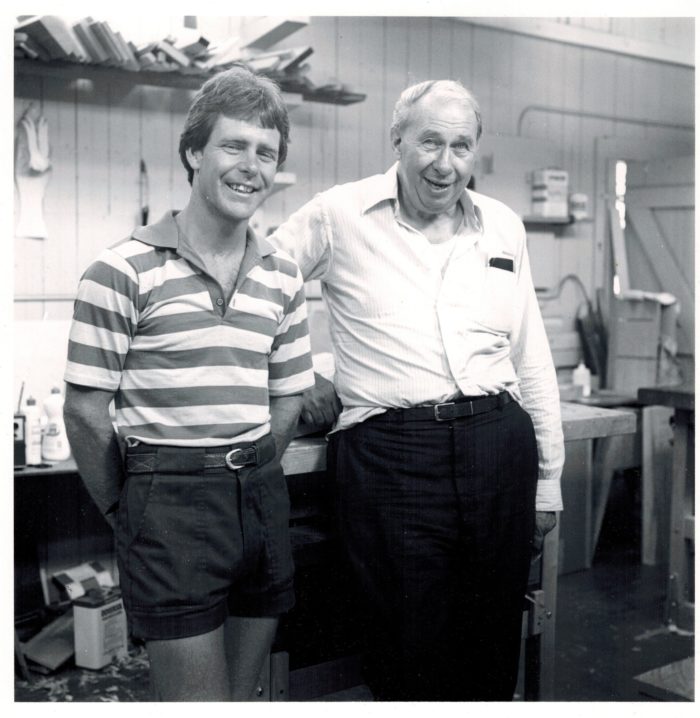
The people who took courses at his school were always escorted to the museum in Salem, Mass., and followed him around as he would describe in detail how many of the antique furniture pieces were constructed. There were always many visitors to the museum who would bend an ear to listen to Phil describe to us the way a certain piece was made. After the tour, we were all treated to a nice meal at the museum and our talk then turned to how Phil had nonchalantly explained his love for furniture.
First to his wife, Sandra, and his daughters, Sonia and Vivian, we pass along our deepest sympathy. Also, to the students who were currently enrolled in his school, who never got to experience the complete course with Phil.
There are so many of my own memories of Phil and me when we first met at the North Bennet Street School. We had both just completed our tours of duty with the active military service. Phil was just another student and his work was of a very high quality from the start. His plan was taking shape.
I have so many wonderful memories of the person that I always considered to be my brother. We just thought alike and that was strange in itself. We did not always agree on the different aspects of the furniture trade or on many other issues, but we always agreed to disagree and then continued to talk about it. A great aspect of Phil.
In life, we have many acquaintances but we have very few people who are a true, sincere friend. Thank you, Phil, for being that true friend. You will be deeply missed.
—John Potter
Whenever I spoke to Phil we would inevitably find that we came to similar low-tech solutions to common woodworking problems. Such a great guy! I’m going to miss just knowing he’s out there.
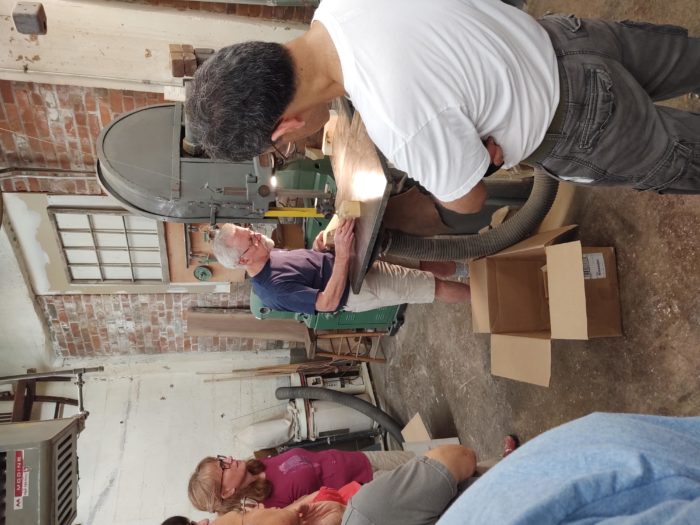
I’ve described Phil many times as one of the greatest living furniture makers. He has recreated plenty of the most intricate and beautiful furniture forms that we know of, and has repaired and refurbished priceless artifacts that other makers wouldn’t even consider touching for fear of messing something up. A mutual friend once said Phil was the only guy that wouldn’t freak out when taking a handsaw to a 200-year-old heirloom worth millions of dollars. Another friend nicknamed him “Gandalf” because “he has a gray beard and does magic.”
Phil’s school was one of few schools in the country where you could learn the chops to tackle the “high styles” of period furniture with the same techniques and build quality used by the old masters. For all that, you would think his shop to be a vast modern woodworkers paradise—the kind you’d design if you were given a blank slate and an open checkbook. Well, it wasn’t. In fact Phil’s shop, at first glance, is startlingly spare. All Phil needed was a small room that manages to house a handful of basic workhorse machines, a drafting room, and a small workbench in front of a wall of hand tools. That was the first lesson: It’s not about the stuff you have.
When Phil traveled to woodworking events he would regularly bring student projects to show off. In a way, the student projects were Phil’s work, and the pride he took in their progress and achievements was obvious. People who had completed his program years ago regularly stopped by to say hi and help out around the shop. Phil built a community without really trying, based on his selfless devotion to passing on his knowledge and skills so that others might also do what they love for a living. Lessons 2-10 are in there somewhere.

I don’t think I know of another person who possesses the same ratio of “top of the food chain in their field” to “humble, polite, and authentic.” Here was one of the greats, plain and simple. There was nobody he didn’t have time for. If you were carrying something heavy he’d grab an end. If you didn’t have the ideal tool for a task he’d lend it to you. If you needed to work something out for payments he was generous and understanding. He’d keep the shop open late or get in an hour early if someone needed extra time.
I’m going to miss him. Many others who knew him better will miss him much more. It was an absolute privilege to get to know him and call him a friend. I’m hoping to be able to hang on to the lessons Phil taught me by example for as long as possible. My condolences to the Lowe family and his tight community of makers. We lost an absolute legend.
—Roger Benton
The passing of my brother, Phil, gave me pause to remember him in many ways. I have furniture that he made for us that we often joked would be “the original Phil Lowe originals.” But, long before he made our treasured pieces, he built a table for our parents while in high school. Our dad died in 2005 and the attached poem is the eulogy our son, Phil’s nephew, gave proving that Phil didn’t just build furniture, he built memories. In light of all the sadness in the world today, it is fitting that Phil inspired the sentiment that it expresses.
—Madeline Lowe Osiecki
There is a table
In my grandfather’s house,
Not much smaller than
The kitchen it occupies.
It is a simple,
Yet, creative design,
Strong and proud
With a bit of shine on top.
It’s a little thicker
Than it needs to be
And not very easy to move.
There are a few scratches
Here and there,
With a dent or two
From falling fists
That tried to make a point
Or silence the screeching
Monkeys at dinner.
Somehow its imperfections
Are all perfectly placed.
There is a table
In my grandfather’s house
With four chairs, two stools
And a hundred places to sit.
A place for a devoted
And Loving wife,
A daughter and three sons.
A dozen grand kids and
Even a few great ones.
There is a place to eat,
A place to read,
A place to nap.
There is a place for
Yankee Fans Red Sox Fans
Republicans and Democrats.
A place to argue, tease,
Talk, Laugh and share.
A place to grow up and
Grow old together.
It has been our meeting place
For as long as I can remember.
I learned many things
At that table.
The most important is
How to Listen
To those you Love
Even when
They are completely wrong.
There is a table
In my grandfather’s house.
I have never known
Another one like it.
—Daniel A. Osiecki


















Comments
I met Phil once, a gifted man with a smile
A great tribute to a remarkable man and craftsman.
After seeing Phil present an overview of his work at the Peabody Essex Museum and reading a half dozen of his articles from the archives, I had the pleasure of taking the most basic of basic woodworking classes with him: hand tool sharpening.
Most in the class were complete beginners. Based on his approachability and every-man teaching style, you'd never guess that he was one of most skilled craftspersons of our time.
There were a handful exquisite projects at various stages in the back room, away from the hand tool classroom where hundreds of vintage hand planes and moulding planes overflowed a wall. In the hallways hung ornately shaped legs that looked like they’d been plucked from the Museum of Fine Art. The machine room's "crown moulding" was broken chairs salvaged from the trash--each one a teaching opportunity for how and why joinery fails. In the corner stood a large ebony board worth tens of thousands of dollars, which was a leftover from a Chinese-inspired dining table he'd built several years before for one of his many wealthy clients.
Lunch was pizza, served on an assembly table next to the marquetry horse. While most guys fraternized with each other in the classroom, I sat with Phil between the intimidatingly large jointer and massive lathe, querying him for 45 minutes straight about his work. More often than not, he veered to the more ridiculous commissions: several panels of complex dolphin-themed marquetry, a life-sized replica carving of the head of a client’s dead dog, which now sat on the newel post of her grand staircase. I knew that Phil did incredible work. He insisted that he did work that he was paid to do.
For many readers, woodworking is an outlet for artistic expression that occasionally yields something functional in their house. In my brief interaction with Phil, I got the sense that woodworking was not so much an artistic expression as it was his life and livelihood. In short, a vocation that paid the bills.
While Phil was no doubt a prolific and immensely skilled woodworker and teacher, some have criticized him for not pushing woodworking creatively like a few of those who've written beautiful memories above. I’m not a historian, and I’m barely a hobbyist woodworker. But what I observed in my brief interactions with Phil is that he straddled the world of the seemingly average American just humbly making a living, and the life of a world-class talent whose work can be appreciated by clients who demand the best. He was a true craftsman and gentleman.
Taken from his family, and us, too soon. Enjoy heaven Phil, with its endless supply of mahogany, tools that never dull, and inspiration that never wanes.
Although I've been woodworking off and on since I was a young teenager, I've only been woodworking full-time since I retired from the working world. I stumbled upon Phil's YouTube videos and saved them all to view/review over and over again. What a skilled artist. Phil looked like such a young man in maybe his mid-60's, so might I ask, what happened to him if that is not too personal a question to ask? COVID-19? Or was it just his time at such a relatively young age, given that many men live to be 80+ these days? What are his years of life?
Thank you for publishing these beautiful tributes.
Phil was a beacon, teacher, mention,inspiration, role model and a gentleman .
His passing is a great loss the furniture making communities.
He visited us in Georgia and was such a treat. I had the pleasure of being with him several times in both social and learning environments.
I wish his family the peace of knowing Phil is in a better place now. This loss is great but I hope they take some comfort in hearing the many out pouring of gratitude and admiration for all he contributed o so many of us.
Ken Johnson Peach State SAPFM chapter is
I am just a hobbiest, but I savor my memories of Phil Lowe at Fine Woodworking Live. I vividly remember when he decided to have fun by doing a hand-cut dovetail joint at his top speed. He did it in under ten minutes and it fit perfectly. I also remember that he validated for me the use of water to clean up squeeze out immediately after clamping. He kept a glass of water with a toothbrush close at hand solely for this purpose. This was particularly remarkable because Norm Abram, deservedly much-beloved by many of us woodworkers, was then repeatedly warning his TV viewers NOT to use water because it would weaken the joint, advising instead to remove glue when it assumes a cheesy consistency.
I started woodworking as a hobby about a year ago at 37 years old. I'd never picked up a chisel or handsaw before but had long dreamed of making fine furniture with only hand tools. I was unsure whether I could make anything decent and I even less sure as to where to begin. I made three simple pieces to learn basic joinery but at the beginning of this year was at a loss where to go next. Then I found Phil Lowe's amazing Queen Anne Lowboy series. I'm now halfway through the series and it's already taken my confidence and ability to a place I never imagined I could go so soon. I bought three dauntingly large pieces of rough sawn Cherry from a local sawmill a couple of months ago still unsure if I could even follow along with lesson one of the series. Now thanks to Phil Lowe's incredibly concise and expert teaching I've already carved my first cabriole legs and first relief pattern. I'm now about to turn my first pieces (the acorns) on a mini lathe I picked up.
As someone with severe ADHD, I can't really learn from written materials or follow along with long videos. So Phil Lowe's teaching style has been a revelation for me and I feel so lucky to have found him.
My heart goes out to his family and friends, and I hope they can take some comfort in knowing how greatly he has changed the lives of people like me. I'm sure he will continue to do so thanks to the all the great Fine Woodworking projects he has gifted to us all. Thank you for everything Phil.
Log in or create an account to post a comment.
Sign up Log in